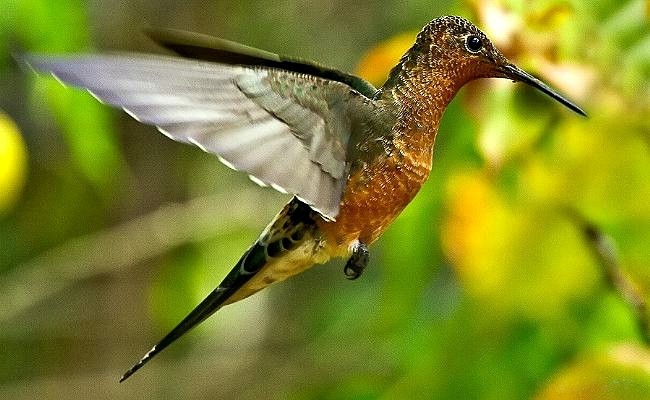Giant Hummingbird
A species of Giant Hummingbird Scientific name : Patagona gigas Genus : Giant Hummingbird
Giant Hummingbird, A species of Giant Hummingbird
Botanical name: Patagona gigas
Genus: Giant Hummingbird
 Photo By Arturo Nahum , used under CC-BY-SA-2.5 /Cropped and compressed from original
Photo By Arturo Nahum , used under CC-BY-SA-2.5 /Cropped and compressed from original Description
In Bolivia, the giant hummingbird is known in Quechua as burro q'enti, the Spanish word burro referring to its dull plumage. Members of P. gigas can be identified by their large size and characteristics such as the presence of an eye-ring, straight bill longer than the head, dull colouration, very long wings (approaching the tail tip when stowed), long and moderately forked tail, tarsi feathered to the toes and large, sturdy feet. There is no difference between the sexes. Juveniles have small corrugations on the lateral beak culmen. The subspecies are visually distinguishable. P. g. peruviana is yellowish brown overall and has white on the chin and throat, where P. g. gigas is more olive green to brown and lacks white on the chin and throat. The giant hummingbird occasionally glides in flight, a behavior very rare among hummingbirds. Its elongated wings allow more efficient glides than do those of other hummingbirds. The giant hummingbird's voice is a distinctive loud, sharp and whistling "chip". 
Size
23 cm
Colors
Brown
Black
Green
Yellow
Gray
White
Nest Placement
Tree
Feeding Habits
Giant Hummingbird mainly consumes nectar and occasionally insects for protein and minerals. Post-reproduction, females ingest calcium-rich materials. Giant Hummingbird feeds on various flowers, like Puya and cacti species, adjusting foraging due to nectar robbing, vital in its high-energy lifestyle.
Habitat
Giant Hummingbird thrives in the highlands of the Andes Mountains, preferring arid, open spaces with low vegetation. Their habitat, extending from sea level up to altitudes over 4000 meters, includes steppe-like hillsides, shrublands with thistles and cacti, and woods with Polylepis and Buddleia trees. They are also adaptable to urban gardens and agricultural areas.
Dite type
Nectivorous
Migration Overview
P. gigas migrates in summer to the temperate areas of South America, reaching as low as 44° S. Correspondingly, it migrates north to more tropical climates in winter (March–August), though not usually venturing higher than 28° S. 
General Info
Feeding Habits
Bird food type
Behavior
Hummingbirds are extremely agile and acrobatic flyers, regularly partaking in sustained hovering flight, often used not only to feed on the wing but to protect their territory and court mates. P. gigas is typical in that it will brazenly defend its precious energy-rich flower territory from other species and other giant hummingbirds. These birds are typically seen alone, in pairs or small family groups. 
Distribution Area
The giant hummingbird is widely distributed throughout the length of the Andes on both the east and west sides. P. gigas typically inhabit the higher altitude scrubland and forests that line the slopes of the Andes during the summer and then retreat to similar, lower altitude habitats in winter months. The species persists through a large altitude range, with specimens retrieved from sea level up to 4600 m. They have shown to be fairly resilient to urbanisation and agricultural activities; however, the removal of vegetation limits their distribution in dense city areas and industrial zones. P. g. peruviana occurs from Ecuador to the southeastern mountains of Peru and P. g. gigas from northern Bolivia and Chile to Argentina. Contact between subspecies is most likely to occur around the eastern slopes of the north Peruvian Andes. 
Species Status
Not globally threatened.
Scientific Classification
Phylum
Chordates Class
Birds Order
Swifts and hummingbirds Family
Hummingbirds Genus
Giant Hummingbird Species
Giant Hummingbird